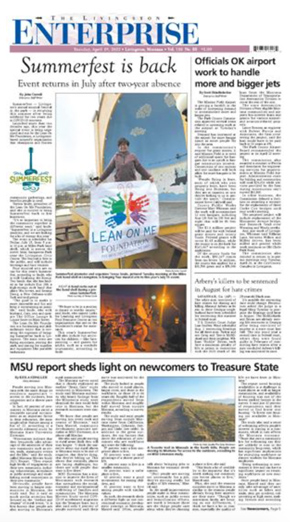 As recently as 40 years ago afternoon papers outnumbered morning publications by almost 4 to 1 in the U.S. As recently as 40 years ago afternoon papers outnumbered morning publications by almost 4 to 1 in the U.S.
By 2000 the number of morning papers had surpassed the afternoon total, though there were still more than 600 of the latter. These have since disappeared so quickly it's almost as if a comet struck the industry—sometime in the afternoon.
When I queried trade magazine Editor & Publisher, its associate publisher, Robin Blinder, emailed, "We're not aware of any remaining afternoon dailies in print."
Well, maybe it's easy to overlook the Enterprise, with its 2,500 circulation, and the Star, which distributes 1,800 copies. Indeed, considering the modern media landscape, it is hard to fathom why any publisher would cling to a 2:30 p.m. press time. So I put in a call to John Sullivan, whose Yellowstone Newspapers owns both dailies.
"Here in Montana, it would be very difficult to hire staff to work at night and almost impossible to find carriers to deliver the papers before dawn when it's 20 below," he said. "Most important, our readers like getting an afternoon paper, and if it's late they're not shy about letting us know."
Mr. Sullivan says his two dailies are losing money. "Business is precarious at the moment," he concedes, "but I see no reason to switch to mornings." Such a move saved many papers, such as the Denver Post and the New York Post, which years ago gave up trying to battle evening traffic for distribution and evening television as competition.
If there are other dailies printed in the afternoon, I couldn't locate them. What I did find was nostalgia.
In his recent book, "Chasing History," Carl Bernstein, who was born in 1944, writes about using a red wagon at age 12 to deliver the Washington Star, and four years later landing a copy-boy job at the paper, where he learned the rhythm of afternoon newspapering—a type of work that tested journalists' adrenaline flow like nothing else.
"If something big happens we hold our press run even later," Justin Post, the Enterprise's managing editor, told me. "It gets pretty exciting. Subscribers like reading today's news today."
Of the 13 carriers who home-deliver the Enterprise, three are children. One of them, a high-school freshman named Aden, delivers 60 papers after school, for which he earns about $7 a day plus tips. He and Mr. Post are the last of a dying breed.
A recent article in the Enterprise began, "Students from the Sleeping Giant Middle School in Livingston spent Thursday at area businesses learning about potential careers."
As news, the story wasn't much, but the fact that it reached doorsteps by Thursday evening was notable.
Regrettably, there was nothing in the report about potential careers at an afternoon newspaper.
(c) Peter Funt. This column originally appeared in The Wall Street Journal.
|



 As recently as 40 years ago afternoon papers outnumbered morning publications by almost 4 to 1 in the U.S.
As recently as 40 years ago afternoon papers outnumbered morning publications by almost 4 to 1 in the U.S.